Content
- 1 Place for planting strawberry and strawberry seedlings in spring
- 2 Strawberry precursors for proper spring planting outdoors
- 3 Soil for planting strawberries: how to properly prepare the ground in spring
- 4 Preparing the soil and beds for planting strawberries in early spring: what fertilizers to apply
- 5 Scheme of planting strawberries in spring in the open field
- 6 Distance between strawberry bushes when planting
- 7 Ways and options for planting strawberries in the beds (with photo)
- 8 Fertilizers required for planting
- 9 The consequences of overfeeding strawberries
- 10 Additional fertilizers when planting
- 11 Learn more about feeding strawberries
- 12 conclusions
- 13 Video about autumn feeding of strawberries
- 14 When to plant strawberries in spring, in what month: timing
- 15 How to plant strawberries in spring: features and step-by-step instructions
- 16 Care for strawberries after planting
- 17 Features of planting strawberries in spring in different regions
- 18 Possible mistakes when planting strawberries in spring
- 19 Nuances of agricultural technology
- 20 General rules for planting in spring
- 21 Hole locations
- 22 Further care
- 23 Do you know?
Place for planting strawberry and strawberry seedlings in spring
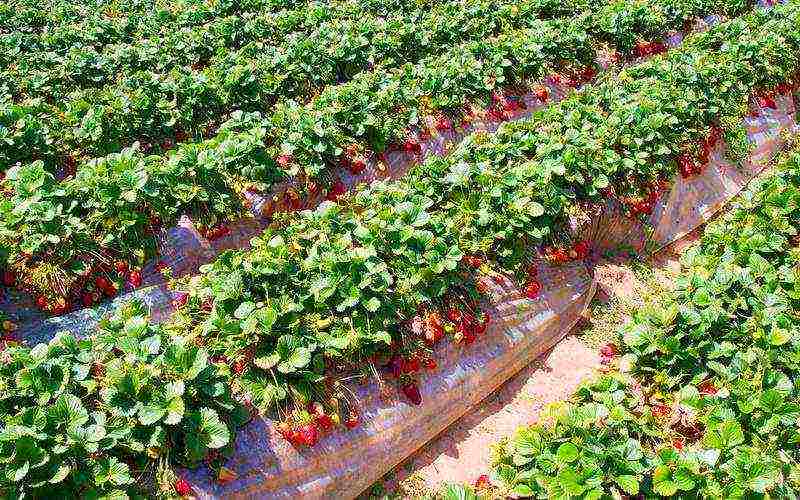
Planting strawberries in the photo
When choosing a planting site for strawberries on an area where the culture will be comfortable, take into account its biological characteristics. First of all, we remember that strawberries are very light-requiring. The quantity and quality of strawberries is directly proportional to the amount of solar energy received by the plants. For this reason, we choose the sunniest place for planting strawberry seedlings in the spring. The duration of the illumination of the berry with direct sunlight should be at least 8-10 hours a day. Even with slight shading, all varieties have a 7-10 days delay in flowering and ripening of berries, the overall yield is greatly reduced and, most importantly, the taste of berries is sharply deteriorating. The fruits become more watery and sour. Yield losses from gray rot in shaded areas increase, and the leaves are more susceptible to all kinds of fungal infections.
In places with light openwork shading - under the crowns of mature fruit trees - only small-fruited strawberries can be planted for effective use of the area. In this crop, the decrease in yield from shading is the least noticeable.
The second, which in no case should be forgotten, is that strawberries are a very demanding crop for the level of soil fertility. Therefore, when choosing a place for planting strawberry seedlings in the spring, we allocate the most fertile areas for it.
Be sure to pay attention to the mechanical composition of the soil and the water regime. According to the mechanical composition of the soil, the best option for planting strawberries and strawberries is light loam. In areas with heavy clay soils and in damp lowlands with stagnant moisture in the autumn-winter period, strawberries grow very poorly.The root system rots, leaves and berries are severely damaged by fungal diseases. Areas with groundwater occurrence closer than 1 meter are of little use for strawberries.
With regular watering and feeding, strawberries thrive on soils with a high sand content. But southern slopes with light soils and areas on elevations are still not the best option. In winter, on slopes, especially steep ones, strawberries can freeze a lot due to the fact that snow blows off the plantings. In dry years, which have become more frequent in recent years, plants will suffer from overheating and lack of moisture. In this case, it is necessary to foresee the possibility of watering in advance.
The following shows planting strawberries in spring in a video that demonstrates all the technology:
Strawberry precursors for proper spring planting outdoors
Science recommends that part of the strawberry plantings be renewed annually, but return to the old place after 3 years, alternating the cultivation of berries and vegetables. It is clear that there are not so many suitable places for such a demanding crop in ordinary summer cottages, and it is not realistic to ensure compliance with a long crop rotation. In critical cases, it is necessary to take a break between planting strawberries after strawberries for at least a year.
The best option is the spring planting of strawberries in black steam, that is, on a plot that is cultivated all summer, but nothing is planted there.
All plants of the nightshade family (tomatoes, potatoes, peppers, eggplants) and pumpkin plants (zucchini, squash and pumpkin) are excluded from the number of predecessors for the correct planting of strawberries. The cultivation of these plants increases the general infectious background in the soil - it provokes the development of various root rot.
Ornamental crops are dangerous predecessors of strawberries when planting, as well as strawberries prone to root rot, annual asters, clematis, chrysanthemums, gladioli and other bulbs.
Crops such as onions, garlic and beets as precursors can trigger an outbreak of soil nematodes. For this reason, their proximity to strawberry plantings is also undesirable.
Excellent precursors for spring planting of strawberries in the open field, capable of improving the soil, are green manure plants - nasturtium, mustard, phacelia or vetch-oat mixture. After growing green manure, their green mass is crushed and plowed into the soil, which can be considered equivalent to the introduction of 1.5-2 kg of rotted manure per square meter of area. The application of organic and mineral fertilizers can be transferred under green manure, which will significantly reduce the further weediness of the site.
On the scale of a garden plot, it is not always possible, but you need to try to place strawberry beds away from plantings of raspberries and apple trees. In spring, during flowering, they have a common dangerous pest - the raspberry-strawberry weevil.
The presented strawberry planting in the photo demonstrates how to choose the right place:
Soil for planting strawberries: how to properly prepare the ground in spring
Haste in preparing the soil for planting strawberries and saving organic and mineral fertilizers during the main refueling is a common and difficult to eliminate later mistake of many gardeners.
If the soil for planting strawberries is set aside in a new area where there is a natural grass stand - sod, then the soil begins to be prepared at least a year in advance. Previously cultivated areas begin to prepare for spring planting in the fall, for the summer-autumn period - about a month before the intended planting.
Before preparing the land for planting strawberries, it is quite possible to apply herbicides in heavily weedy areas to remove the most harmful weeds such as bindweed, wheatgrass, lily and thistle.
The optimum level of soil acidity for planting strawberries in spring is 5.2-5.5 pH.If the soil on the site is more acidic, then it is advisable to deoxidize liming one to two years before planting strawberries. Before planting strawberries in the spring correctly, you need to know that the approximate dose, depending on the initial acidity, is from 400 to 600 g of lime or dolomite flour per square meter. Dolomite flour is preferable, as it additionally enriches acidic soils with magnesium.
Before preparing the soil for planting strawberries, you need to decide where to grow: on high ridges or on a flat surface? The question remains open, since the correct answer to it depends solely on the microclimatic features of the site and the degree of soil cultivation. On heavily weedy, heavy clay soils and uncultivated damp areas (where plants suffer more from excess moisture and lack of heat), the construction of ridges from 10 to 30 cm in height with completely filled soil is often the only possible way to grow strawberries. On dry areas with light sandy soils (where plants suffer more from overheating and lack of moisture) or areas with a high degree of cultivation (low weediness, optimal soil texture), it is quite possible to successfully grow strawberries on a flat surface.
But whichever method you choose, preparing the land for planting strawberries after removing weeds begins with a thorough digging to the maximum possible depth. The most modest option is the depth of the full bayonet of the shovel, that is, at least 25-27 cm.
Preparing the soil and beds for planting strawberries in early spring: what fertilizers to apply
Since more than once we have already reminded that strawberries are a very demanding culture for the level of soil fertility, in order to enrich the deep layers with nutrients, organic and mineral fertilizers should be applied to the dug (plowed) area, which is called the main pre-planting soil filling. The amount of fertilizer applied can vary depending on the level of fertility and predecessors. What fertilizers to apply when planting strawberries depends on the condition of the soil and its grooming. For an ordinary household plot, when preparing the soil for planting strawberries, you can focus on the average doses - 6-10 kg of organic fertilizers (lowland peat, rotted manure (humus) or summer cottage compost), 100 g of superphosphate and 120 g of potassium sulfate are applied per square meter. It is quite possible to replace phosphorus-potassium fertilizers with ash at the rate of 150-200 g per square meter.
If planting strawberries in early spring will be done on heavy soils, it is advisable to add sand to improve the texture.
After the second digging and incorporation of nutrients into the soil, the surface is leveled with a rake, breaking up large clods. After that, they begin to build ridges or break out rows, depending on the chosen cultivation option.
Agronomists advise to form rows or beds for planting strawberries along the north-south line. In this case, all plants will be evenly illuminated during the day, first from the east, then from the west. With a different orientation of the rows (east-west), the berries on the north side of the bush when ripe are less colored.
Correct planting of strawberries in open ground in the video will allow you to accurately reproduce this process on your site:
Scheme of planting strawberries in spring in the open field
The correct scheme for planting strawberries in spring should provide the plants with an optimal level of illumination and mineral nutrition, and for the gardener - the convenience and safety of all maintenance work, as well as effective use of the area. For these important reasons, it is necessary to approach the choice of the landing pattern quite seriously.
The main rules for planting strawberries in the spring should be available for familiarization to all novice gardeners.
- To obtain a harvest of berries, all common varieties of large-fruited strawberries can and even be planted side by side. They have similar requirements for agricultural technology, and this is good for cross-pollination. It is quite possible to plant red and white-fruited varieties next to it, they will not change their color from the neighborhood.
It is not recommended to plant remontant varieties on the same bed with the usual ones, since the latter require increased attention and care, a different regime of fertilizing and watering.
Small-fruited strawberries and earthworms are best planted in separate beds or areas.
- The length of the ridges or rows is mainly determined by the size and configuration of the site, as well as by issues of convenience and technology for further caring for the plants. It is necessary to foresee in advance convenient and safe paths for the passage during irrigation and travel with a garden cart when feeding and weeding.
- The choice of the row spacing is determined by the search for a balance between the issues of ease of carrying out plant care operations and the efficiency of using the area of the site. Wide row spacings of more than 70 cm provide convenience when working, good lighting and mineral nutrition of plants, but low efficiency of use of the area. Narrow row spacings - less than 40 cm - allow placing many plants per unit area, but significantly complicate maintenance work. In addition, in strongly growing and "mustachioed" varieties, plantings thicken quickly. This, in turn, worsens the conditions for the growth and development of plants, provokes an outbreak of fungal diseases.
The optimal size of the row spacing can be called a value from 40 to 70 cm.
Distance between strawberry bushes when planting
The distance between strawberry bushes when planting in rows largely depends on the varietal characteristics and the method of cultivation. When planning an intensive cultivation technology with a quick change of plants (no more than 2 seasons), the planting scheme is chosen more dense with minimal distances between rows and between plants. If you plan to use plants for a long time, then a more rarefied planting of plants is preferable.
When buying seedlings, it is important to find out from the seller or later from other sources information not only about the size of berries and yield, but also about the height, foliage and "mustache" of the variety. The planting scheme and, accordingly, the required amount of planting material depends on this. According to scientific recommendations, vigorous, densely leafy and "mustache" varieties should be planted with a large distance between plants in a row from 30 to 40 cm. For low-leafed and low-mustache varieties, these standards are reduced to 20-30 cm.
When determining the scheme for planting strawberries in the open field, think in advance about whether you plan in the future not only to receive berries, but also to update strawberries on your own by planting a mustache. In this case, it is necessary to provide for a spatial isolation of at least 1 m between the varieties. Otherwise, in less than a season you will get a real "Olivier" from varieties in which more mustachioed varieties will displace less fertile neighbors.
Ways and options for planting strawberries in the beds (with photo)
For any method of planting strawberries, the general rules should be followed: soil preparation should be completed in one to two weeks, there should be no large clods, it is dangerous for survival to plant seedlings in non-settled soil, it is advisable to spill the prepared area a day or two before planting. On hot summer days, it is better to plant seedlings in the evening hours.
For seedlings with an open root system, the plants are disinfected on the day of planting to prevent root rot or leaf spots. For these purposes, a solution of potassium permanganate is suitable - 1 g of dry matter per 10 liters of water. In this solution, the plants are washed.Another good way is to keep the seedlings in a solution for 5 minutes, for the preparation of which 2 salt spoons of table salt and 1 teaspoon of copper sulfate are taken for 5 liters of water. After that, the seedlings must be rinsed with clean water.
The methods of planting strawberries in the beds are most optimal for flooded, damp and clayey areas. For the convenience of planting, use a scoop or other similar device. With its help, a hole is dug a little deeper and wider than the size of the plant's root system. If the soil is dry, then each hole should be shed. Water consumption 0.5-07 liters per well. Next, the seedlings with a lump of earth are removed from a plastic cup and placed in the center of the hole. Peat cups are not removed, so as not to damage the root system once again.
When sprinkling plants with soil, remember the “golden rule of strawberries”. In no case should the heart be buried. If you are not sure that you can place it at the level of the soil, then it is better to leave it a little higher than at least a little, but to deepen it. High planting defects are not so dangerous and are corrected in the future by mulching. Deepening (especially when planting before winter) cannot be corrected, and its consequences are detrimental to the plant.
After sprinkling the plant with soil, we squeeze it around with our hands so that air cavities do not form around the roots and the roots immediately get in contact with the soil. To check the quality of planting, you can pull on the leaf: if the plant is not pulled out of the ground, it is planted correctly.
Immediately after planting, young bushes must be well watered and done regularly (in the absence of rain) for another 7-10 days. The addition of biological growth stimulants such as humates to irrigation water contributes to the active growth of young roots and plant survival.
Look at the options for planting strawberries in the photo, which shows all the technologies and methods:
If the weather is dry and hot when planting seedlings with an open root system, then such plants in the daytime should be shaded from direct sunlight using white agrotechnical cloth or paper. They take longer and more difficult to take root than plants with a lump of earth; they stop withering at midday, as a rule, only after two to three weeks.
Recently, one often hears controversy about whether it is good for strawberries to grow with continuous mulching (covering) the soil surface with agro-fabric - a black non-woven material. This method has several undeniable advantages for gardeners in the form of a significant reduction in labor costs for weeding and a decrease in soil moisture evaporation in arid regions. However, we advise you to use it with great care - after all, the continuous cover of the soil surface makes it impossible to regularly carry out loosening and digging of row spacings. In damp areas, it significantly complicates the ventilation and drying of the soil.
The use of a plastic film impermeable to air and moisture as a covering is detrimental to strawberry plants.
But the most important problem is the impossibility of carrying out a procedure that is beloved and necessary for strawberries - mulching plants with a layer of organic matter. For these reasons, with all the convenience for the gardener of this method of growing, it can be considered positive, of course, and cannot be recommended for widespread use.
Rate the article:
(1 vote, average: 3 out of 5)
Strawberries perfectly absorb fertilizers. If you produce systematic fertilizers, then yield can be increased by 20%, while the fruits will be large and juicy. Particular attention should be paid to the introduction of nutrients during the planting period.
Fertilizers required for planting
Before planting, you need to make the following fertilization: dig up the soil and mix it with manure (compost can be used) and mineral dressings... For 1 square meter of land you need 10 grams of potassium chloride and 30 grams of superphosphate.
It is required to adhere to the proportions when mixing:
- 2 glasses of wood ash;
- 1 bucket of manure or compost;
- 1 bucket of soil.
Such a composition should be placed on a sandy surface and strawberry seedlings should be planted.

All components are mixed and placed at the strawberry planting site.
Fertilizing strawberries when planting in spring
In order for the culture to give a rich harvest, it is first necessary to carry out top dressing, which activates the growth of the plant.
The introduction of such components will prevent all kinds of diseases in the future, and rid the strawberries from pests. One of these fertilizers is considered ammonium nitrate from ammofosk in a ratio of 1: 2... The resulting mixture must be additionally diluted in water. Watering with a solution is required at the root (15 grams of top dressing per 1 square meter). Many gardeners replace this solution with zircon. The benefit of this component is that it removes nitrates.
Fertilizing strawberries when planting in autumn
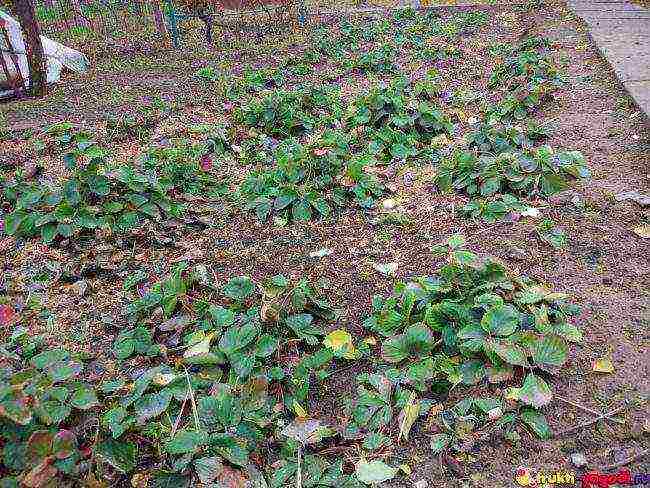
In the fall, bird droppings will help strawberries.
Fertilizing strawberries when planting in autumn is necessary in order for the plant to take root and survive the winter cold.
As a fertilizer, you can use bird droppings... It is enough to spread such a substance between the rows, after planting the plant (without adding to the soil). Thanks to the nitrogen content of the droppings, strawberries will root quickly. Before the onset of frost, you need to carry out one more top dressing - mineral.
Features of autumn feeding

Composting strawberry beds with sawdust.
Fall dressing is important when planting, as it ensures yields in the following season.... Fall dressing has a number of advantages:
- Sawdust, peat, straw and fallen leaves added to the soil will rot by the spring and settle in the soil, saturating it with nitrogen.
- On the eve of mulching, potassium humate or superphosphate should be added to the soil. Such substances dissolve for a long time, which will ensure the saturation of the soil with the necessary components for a long period of time.
- To save manure, it can be diluted with water (1: 1) and infused for at least 10 days. Pour the solution between the beds.
- Before planting strawberries in the fall, you need to start preparing the soil 2 weeks before the expected planting date. It is recommended to add double superphosphate to the soil.
But you can also get balanced feeds from the store. A positive feature of using ready-made fertilizers is that there is no risk of overfeeding strawberries.
After planting strawberries in the fall, it is recommended to sprinkle coarse sand between the beds. Such an event will protect the plant from various kinds of pests.
The consequences of overfeeding strawberries
In the spring, it is important not to overfeed the culture.

When using any type of fertilizer, it is important to adhere to the application rates.
If fertilizers are applied with an excess, this will adversely affect the condition of the plant, and in some cases can lead to the death of the bushes. When applying a large amount of nitrogen-containing dressings, you can get large green bush without fruit.
But you can overfeed the plant with absolutely any fertilizer (mullein, manure, chicken droppings). If fertilizer was applied with a surplus, then no more components should be added to the soil during the year.
Additional fertilizers when planting
There are additional fertilizers when planting strawberries, which, according to gardeners, have a positive effect.
Fermented milk products, yeast, nettle infusion (used only as a foliar feeding method). For strawberries, acidified soil is preferable, so these methods have a fruitful effect on the culture.
Dairy products
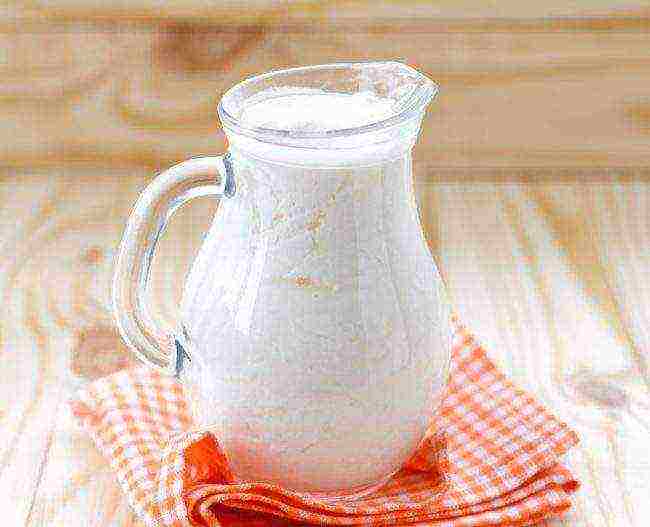
After watering with whey, the soil becomes slightly acidic, and this is an excellent medium for the growth of strawberries.
- When fertilizing the earth serum, the earth is saturated with calcium, phosphate, nitrogen, sulfur and other useful components.
- And also you can mix fermented milk products with manure, wood ash.
Yeast feeding

You can also add a few drops of iodine to the bread infusion.
Using yeast feeding, the soil is acidified, and the plant activates its growth.
To prepare a yeast top dressing, you need to soak the bread for 7 days, then dilute the resulting composition with water (1:10).
Nettle infusion
To prepare such a tincture, you need to soak the nettle in water for 10 days. The finished infusion must be diluted with water (1:20).

To prevent the nettles from floating, a load is placed on top.
And you can also use the following dressings (diluted with 10 liters of water):
- Ammonium nitrate - 1 tablespoon, manure - 450 milligrams.
- Iodine - 30 drops, wood ash - 1 teaspoon boric acid - 1 teaspoon.
- Potassium permanganate - 3 grams, boric acid - 0.5 teaspoon, ash - 250 grams.
These dressings must be applied at the root of the strawberry. They promote the growth of the plant and the formation of large berries.
Learn more about feeding strawberries
Initially, any soil is saturated with useful components, but after planting a plant, it begins to lose useful components. This is due to the fact that the soil gives off nutrients to the plant and is gradually depleted. Within 3 years, if the soil is not nourished, it will lose all its beneficial properties.

Lack of any nutrients in the soil negatively affects the growth of strawberries.
If strawberries lack any useful components, then initially this is reflected in the size and general condition of the berries. If initially the strawberries bore large fruits, but over time the berries became smaller, then you need to change the fertilization regime.
Each strawberry variety requires individual feeding... Initially, it is difficult to determine which component a plant needs. It is also required to take into account the condition of the soil. Therefore, it is quite problematic to select fertilizers, and this requires a long period of time.
conclusions
It is necessary to monitor the condition of the fruits and bushes of strawberries, to apply top dressing and fertilizers in time, and also to water the plant in a timely manner. Only this approach will ensure a rich harvest.
Video about autumn feeding strawberries
Strawberries are a capricious culture that requires a lot of attention and care. For the successful cultivation of the berry, it is especially important to plant the plants correctly. What do you need to know about planting strawberries in the open field in spring?

When to plant strawberries in spring, in what month: timing
Planting dates for strawberries are determined based on weather conditions and soil conditions. As soon as the temperature stops dropping below + 15-16 C, and the land becomes suitable for cultivation, the seedlings begin to be planted in the ground. Depending on the region of cultivation, the berry is planted on the site in March and the first half of May.
The advantages and disadvantages of planting strawberries in the spring. When is the best time to plant - in spring or autumn?
The appropriate timing depends on the variety of strawberries and the purpose of their cultivation. So, seedlings with a closed root system are best planted in late summer or early autumn. It is advisable to plant seedlings with an open root system in early spring or at the end of summer. It is preferable to plant regular varietal strawberries in late August-early September, and remontant strawberries in April-May.

Benefits of planting strawberries in spring:
- By autumn, the bushes have time to form a powerful root system, making them less susceptible to freezing.
- If the bush dries up, you can transplant it right away.
- Since the soil absorbs melt water, the plantings need to be watered less often.
The main disadvantage of spring planting is that in the first year the plant bears poor fruit. Therefore, if you plant strawberries in the spring, then you will have a rich harvest only next year.
In southern regions, where winters are not very harsh, it is better to plant strawberries in early September. Autumn planting due to the fact that at this time there is a sufficient amount of planting material, and the planted plants root well.
Video: when is it better to plant strawberries - in spring or autumn
How to plant strawberries in spring: features and step-by-step instructions
In order for strawberries to take root in a new place, you need to follow the rules of spring planting exactly. What are the nuances worth knowing for successful cultivation of a culture?
What should be a seedling
Planting material for spring planting can be bought in nurseries or grown on your own. Purchased seedlings are:
- With a closed root system (ZKS). Whiskers with 2-3 leaves, rooted in cassettes or containers, have good survival rate. When buying such seedlings, you need to carefully inspect the cups, since unscrupulous sellers can sell seedlings with ACS under the guise of cassette seedlings for enrichment purposes. Good quality is evidenced by protruding root tips from the drainage holes of the container.
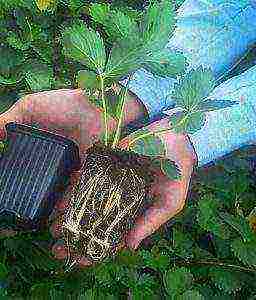
- With an open root system (OCS). The seedlings are rooted in the ground without root isolation. Such seedlings have poor survival rate than seedlings with ZKS, but the cost is much cheaper. It is better to buy seedlings from a seller who regularly spray the roots with water.
Important! When buying, you need to pay attention to the heart (growth point): the larger it is, the more abundant the harvest will be.
In order to grow strawberry seedlings on their own, in a year harvests from mother bushes cut off peduncles and extra sockets, leaving only a couple of the strongest ones. Once the mustache has developed strong roots, the young plants are separated from the bush and planted in containers or frozen using the Frigo method.
Note! It is necessary to plant young seedlings, not old ones.
Video: how to choose strawberry seedlings and distinguish young from old
Pick-up location
Strawberry beds should be straight, north-south or slightly south-west. In order for the bushes to bear fruit abundantly, it is better to plant the bushes in lighted areas, especially for large-fruited varieties. Small-fruited berry can grow in partial shade. Strawberry seedlings can be grown even on a small slope of 2-3 degrees. Berry bushes will grow faster and produce a bountiful harvest.

Important! Strawberries should not be planted in lowlands: the plants will often get sick, and due to poor heating of the earth and the collected cold air, the plant will grow slowly, and the berries will ripen for a long time.
When choosing a place for planting strawberries, you need to take into account the compatibility of crops that grew in the garden last year. The best predecessors are cereals and legumes, lupine and phacelia. The worst are nightshade crops.
Important! You cannot grow strawberries in the same place for several years in a row. Over time, the berry loses its yield and often gets sick, since the plants are constantly infected with diseases that have accumulated in the soil. Re-planting the berry in its former place is possible only after 4-5 years.
What to plant with
Having decided on the arrangement of a strawberry garden, you must first select its location on the site. There are such rules for planting berry bushes:
- Strawberries should not be planted near crops that require the same nutrients as themselves.
- The watering regime for nearby plants must match the requirements of the red berry.
- You can not plant tall plants nearby, which will shade the bushes too much.
- It is not recommended to place near plants with the same diseases and pests.
Based on the above recommendations, strawberries should not be planted next to plants of the Solanaceae and Clove families. You can not place it near the beds with cabbage or raspberries, onions and garlic.
It is better to place parsley, lettuce, spinach, carrots, radish near berry plantings. Beets or radishes can be grown at some distance. Strawberries get along well with beans, lentils and peas.
What soil is needed
Strawberries grow well on black soil and sandy loam soils. Light gray, clayey and turfy soils are less suitable for cultivation. Before digging into heavy soils, it is recommended to apply sand to loosen the soil. It is not recommended to plant this crop in acidic soil. The ideal acidity level for growing strawberries is pH 5.5-6.5.

To increase the yield of such plantings, the plants need to be fed regularly. In order to prevent diseases and prevent pest attacks, 3-4 weeks before planting, the soil is treated with a special solution preheated to 70 degrees C. To prepare the solution, 500 g of copper sulfate and 50 g of potassium permanganate are added to 1 bucket of water. Solution consumption per 1 sq. M of plantings - 1 liter.
What depth to plant
When planting strawberries, you need to ensure that the growing point (heart) is above the soil surface. If the center point is in the ground, the bud will dry out, and if, on the contrary, it is planted close to the soil surface, the roots will begin to dry out. With any of the options, the seedlings will grow poorly and may die.
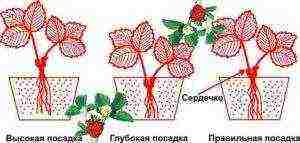
At what distance to plant
Depending on the selected planting method, strawberries are planted at a distance of 7 to 60 cm. The shortest step for planting seedlings is used in the carpet scheme, the longest in the lowercase.
How and what to fertilize the soil before planting
Rotted manure or compost is considered the best fertilizer for strawberries, since they contain all the necessary substances for the growth of the crop. The most valuable organic fertilizer is considered horse dung... Before starting to dig on the surface of the future bed, organic matter mixed with ash is laid out in an even layer, based on the calculation of 2 buckets per 1 sq. For 1 bucket of fertilizers add 1 glass of wood ash.
Video: how to properly plant strawberries in spring to get a good harvest
How to prepare a seedling
Before planting, seedlings with a closed root system (ZKS) are spilled abundantly. Seedlings grown in peat pots are dipped in a container of water for 30 seconds. Strawberries with an open root system (OCS) are dipped in a clay mash. After processing, the roots are cut to 10 cm.
Video: pruning a strawberry seedling before planting
Planting methods
There are a lot of schemes for planting strawberries. Here are the most popular ones:
- Carpet scheme. Seedlings are planted in rows made at a distance of 30 cm. The step between the bushes is 7 cm. The use of this method is very important when there is no time to care for the strawberries. Due to the density of the plantations, few weeds manage to break through. In addition, moisture from the soil evaporates much more slowly than with a line or bush planting.

Important! In the case of excessive density, the berries may be small. The method is not suitable if the plant is planned to be grown in shaded areas.
Video: 4 options (methods) for effective planting of strawberries
Growing strawberries under a black film (on agrofibre)
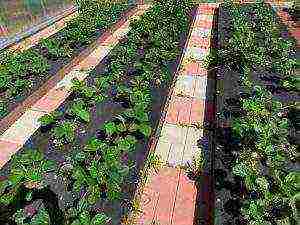
The prepared strawberry bed is covered with a black film with a density of 60 g / sq. When using several cuts, they are laid with an overlap of 20 cm. The ends of the material are applied with bricks, and the central part is fixed to the ground using hooks made of wire. Holes are cut in agrofibre for planting strawberries at a distance corresponding to the selected planting pattern.
By the way! It is best to use this planting method on loose, light soils in moderately warm regions of the country.
Video: planting strawberries on agrofibre
Care for strawberries after planting
So that the seedlings take root faster, immediately after planting the strawberries abundantly watered... Unlike autumn planting, bushes planted in spring do not need to be watered often, since the soil has already absorbed more moisture. In the future, watering is carried out as the soil dries up.
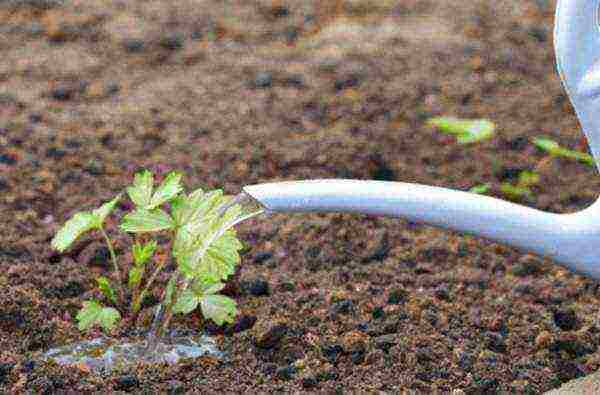
Important! The amount of watering should be moderate. Excess moisture - the main cause of root rot and an excellent environment for the development of gray rot and powdery mildew.
Experienced gardeners strawberry planting for 14 days harbor a thin layer of mulching material. Mulch laid on seedlings works like a greenhouse, since it does not allow moisture to quickly evaporate. Hay, straw, sawdust, spruce branches or rotted compost are used as mulch. Due to the sufficient moisture, the seedlings take root well.
Don't forget in a timely manner weed strawberry beds - a large number of weeds significantly reduces the yield.
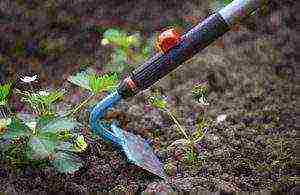
IN feeding needs seedlings growing on poor or poorly fertilized soils. The following fertilizers are used to feed strawberry seedlings:
- Add 1 tablespoon to 10 liters of water. ammonium sulfate and 2-3 glasses of rotted manure. Watering one hole takes 1 liter of solution.
- Nitroammophoska solution. 1 tbsp the substances are diluted in 10 l of water.
- Infusion of mullein and poultry droppings, prepared based on the ratio of 1:10 and 1:20.
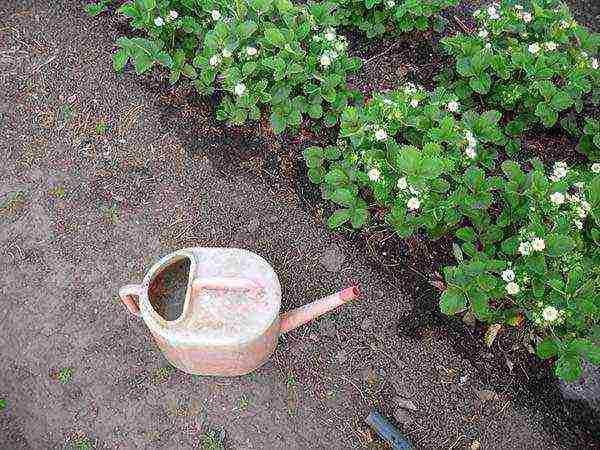
Important! You can not overfeed strawberries with organic matter and complex fertilizers with a large amount of nitrogen.
Video: how to care for strawberries in spring, summer and autumn
Features of planting strawberries in spring in different regions
Due to the fact that the weather in the regions of the country is significantly different, spring planting has some peculiarities.
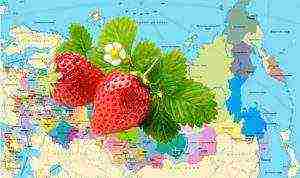
In the Volga region and the Middle lane (Moscow region) due to the temperate climate, spring planting is carried out according to generally accepted rules. In the central regions, strawberries are planted from April to May.
In the Leningrad region planting strawberries can be carried out only at the end of May so that the young, fragile berry is not damaged by frequent night frosts.
In most cases, the soil of the northern part of the country (in Siberia and the Urals) heavy. Since strawberries grow poorly in such conditions, sand or humus is plentifully introduced into the soil before planting. Seedlings are planted, as a rule, on ridges with a height of 60 cm: this way it warms up better and ripens faster. Seedlings are planted in open ground in the first half of May.
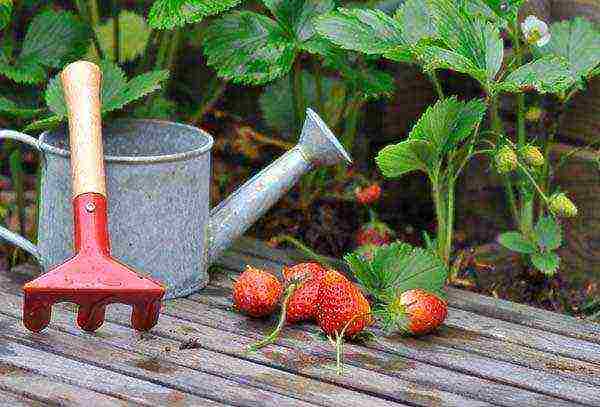
Possible mistakes when planting strawberries in spring
Typical mistakes that beginner gardeners make when planting strawberries:
- Bushes are planted too close to each other. Severely thickened plantings are poorly ventilated, which is why the plants get sick with gray rot, and as a result of a lack of sunlight and nutrients, the berries are too small.
- Under the bushesmake a lot of fertilizer. As a result of the introduction of an excess amount of nitrogen, the leaves begin to grow rapidly, and the formation of berries slows down. Feeding strawberries with manure, the amount of which exceeds the recommended rate, ends with the combustion of the roots. Excessive lime mixtures have a negative effect on the green mass.
- The growth point is buried in the ground.
In order to enjoy delicious berries, you need to carefully follow the planting rules, since any false action can lead to a decrease in yield or even the death of young plants. Therefore, it is so necessary to follow all the recommendations for the correct planting of strawberries in the spring in open ground.
Video: how to plant strawberries in spring
Unpretentious strawberries in favorable conditions take root well in autumn plantings. But the cold winters of central Russia, the Urals and Siberia are often destructive for young bushes. Therefore, in these regions, it is more common to plant strawberries in open ground in spring.
With proper care for winter, berry bushes take root reliably, adapting to the soil and the prevailing climate. Such plants tolerate winter more easily and delight the owners with an abundant large-fruited harvest in the summer.
Nuances of agricultural technology

Boarding time
Strawberry seedlings tolerate low temperatures well, so it is permissible to start planting plants in prepared soil simultaneously with the main field work. 30 days before planting seedlings, it is desirable to process the land from pests and pathogens, which significantly limits the planting period in central central Europe, the Urals, northern regions and Siberia.
In the southern regions of Russia, in the Caucasus and in the Amur region, spring planting of strawberries is permissible from the beginning of March. The moderate continental climate of the Central zone of the European part of Russia implies the planting of strawberries approximately from April 15 to May 5.
In the Urals and Siberia, optimal conditions for planting strawberry seedlings are more often observed from May 1 to May 15. Low temperatures (10-18 ° C) with high soil moisture are the main criteria for choosing the timing of planting strawberries.
Choosing a landing location
Strawberries prefer loose, neutral or slightly alkaline soils rich in organic fertilizers. Bushes growing on loamy or sandy loam soils with the addition of compost or humus bear fruit abundantly with large berries. The critical aspect is the depth of the water table.
If possible, a site with a deep (more than 1 meter from the surface of the earth) occurrence of the aquifer is chosen for strawberries.
Strawberries require good lighting, so the beds are located southwest of tall trees and farm buildings. Ideally, the beds are oriented from north to south. For the surface of the beds, a slope of 2-3 degrees is permissible. Strawberries winter successfully when the snow cover is 20 cm thick, so the planting site requires protection from exposure of the soil by winds in winter.
In the vast majority of cases, strawberries are planted on lands that have been in agricultural production for more than a year.
Therefore, it is necessary to consider the optimal predecessors for strawberries:
- lupine or other siderates;
- cereals;
- buckwheat;
- legumes;
- marigold.
Planting strawberries after the following crops is acceptable:
- onion,
- garlic,
- pumpkin,
- spices,
- carrot,
- beet.
Do not use the site after:
- any species of plants of the family Solanaceae;
- cabbage;
- raspberries,
- cucumbers,
- zucchini,
- fruit trees,
- strawberries and strawberries.
The latter make the soil unsuitable for growing strawberries for 3-4 years.
Soil preparation

Preparing the land for spring planting should begin in August or September by sowing short-lived green manures, such as lupines, beans or mustard, in the planned area.
By spring plowing, the green mass accumulated by the plants will turn into nitrogen-rich humus.
In autumn and early spring, it is possible to prepare fertile soil from uncultivated soil. To do this, use layers of turf 8 cm thick, taken from grassy thawed patches. Layers are placed in a prepared plank box. Each 2 layers are thoroughly spilled with a solution of EM fertilizers (for example, "Baikal") or plain water. The box is not tightly covered with foil. The finished substrate is sieved and distributed over the beds.
River sand is added to the clay soil, in the ratio of 3-5 kg of sand per 1 m² of the plot. Acidic soils need to be alkalized with lime.
When digging up the soil in the spring, organic fertilizers are generously introduced into the soil in the form of completely rotted peat or manure, compost, vermicompost at the rate of 2 buckets per 1 m² of the plot. The ash is evenly distributed in the soil, 2 cups per 1 m².
Hybrid varieties are cultivated on a substrate at least 10 cm thick, consisting of equal shares of peat, river sand, turf and humus.
Before planting strawberries in spring, some experts recommend treating the soil with herbicides. This helps to reduce the concentration of microorganisms that are pathogenic for seedlings. Such processing is carried out no later than a month before planting strawberries.During the same period, official fungicides and insecticides are introduced.
For 10-14 days, the soil is treated for fungal infections with a hot solution of copper sulfate and lime at the rate of 50 g of vitriol and 0.5 kg of lime per 10 liters of water. The solution is heated to 70-85 ° C, after which the planned area is sprayed, adding up to 1 liter of disinfectant per 1 m² of soil.
Strawberry seedlings will be protected from bugs and their larvae by treating the soil with an ammonia solution (10% ammonia 40-50 ml per 10 liters of water) in a dosage of 0.5 liters per 1 m². Planting holes are disinfected with a dark purple potassium permanganate solution, which destroys thrips, nematodes and other pests.
For abundant fruiting, careful weeding of the area for strawberries is necessary with meticulous removal of wheatgrass rhizomes.
Earth is taken out of the holes, mixed with manure and compost in equal proportions, and 2 glasses of ash are added to 3 buckets of mixture. A cone is formed from the resulting soil in the center of the holes, into which strawberry seedlings will be planted.
Planting strawberries in dry soil is allowed, but such a site needs watering in the holes immediately after planting the plants.
Strawberries can be planted in both dry and moist soil in spring.
Selection and preparation of planting material
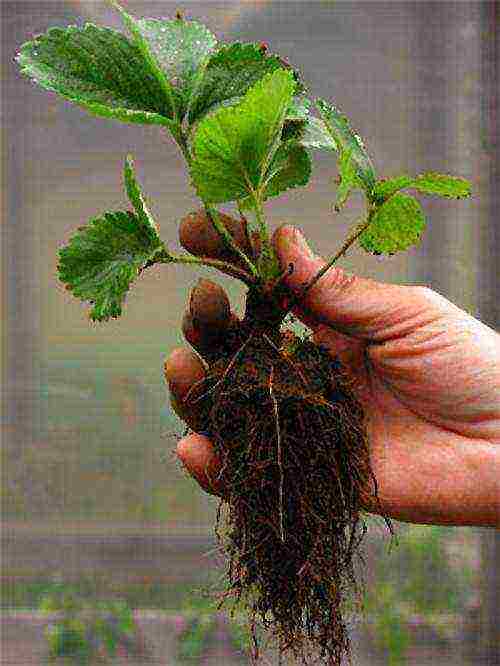 Strawberry seedlings, like other berries, are sold both with open and closed roots.
Strawberry seedlings, like other berries, are sold both with open and closed roots.
Plants with a closed root system, grown in individual containers, are transplanted together with an earthen ball. Such bushes tolerate transportation and transplanting better, and quickly adapt to new conditions.
The danger is associated with the high probability of transmission of diseases and parasites from the soil from the cup, the inability to fully check the condition of the roots of the bush and a higher price. Therefore, unscrupulous sellers can sell unrooted seedlings at a higher price.
When choosing, the drainage holes of the pots and the leaves of the plant are examined. The leaves should be free of pigmentation, of an even green color, and the ends of the roots are visible in the drainage holes.
Berry seedlings with an open root system are less resistant to transport, high temperatures and direct sunlight. It takes longer to take root in a new place, the probability of its death is higher than with closed roots.
However, the low price of the bush, the ability to assess the root system and the ease of processing against diseases and pests make such seedlings preferable for planting in the spring.
Signs of quality seedlings:
- moist, regularly sprayed roots,
- white or slightly darkened root system with a lot of hairs,
- root length 8-10 cm,
- root collar thickness from 6 mm or more,
- healthy, large heart of leaves,
- the aerial part consists of 3-5 leaves on short cuttings.
Before spring planting in open ground, agronomists recommend hardening seedlings at a temperature of 10 ° C for 36-48 hours. Also, the survival of plants increases when the root system is treated with root formation stimulants, clay or soil mash, mullein infusion. Do not forget about karbofos, the treatment with which is detrimental to soil pests.
Some gardeners advise immersing the roots of plants in a vitriol-salt solution (5-7 g of copper sulfate, 30-40 g of salt per 10 liters of water) for 20-25 minutes. Such processing requires rinsing under running water, therefore, it is carried out immediately before planting.
Treated seedlings should preferably be planted in moderately moist soil. Long roots of seedlings can be shortened to the recommended 10 cm.
General rules for planting in spring
 Planting strawberries in spring should be in the evening or on a cloudy day, which will reduce the number of plants killed by strong sunlight. For the same purpose, young bushes can be covered with coniferous spruce branches.
Planting strawberries in spring should be in the evening or on a cloudy day, which will reduce the number of plants killed by strong sunlight. For the same purpose, young bushes can be covered with coniferous spruce branches.
The distance between the bushes is planned taking into account their probable size at the time of fruiting, so the seedling holes are placed 30-50 cm apart.Strawberry seedlings are planted in deep (more than 10 cm) holes, in which mounds should be made from a mixture of soil, compost, manure and ash. Seedlings are placed on these embankments, carefully spreading the roots so that they do not curl up.
During planting of plants in the spring, its root part is immersed in the ground, while it is necessary to straighten all the roots so that they do not wrap up (diagram).
It is necessary to cover the roots of seedlings with earth with great care so that the soil does not fall into the sockets, but at the same time completely hides the root system. With the correct technique, sprinkling is alternated with watering and compaction of the soil, then there is no leaching of nutrients from the near-root soil.
At the end of planting, the soil, if necessary, is watered and mulched with straw, sunflower or rice husks, coniferous litter, sawdust or hay.
After completing the planting of berries, the planting is watered and mulched the soil.
Hole locations
The size of strawberries depends on the distance to neighboring bushes, so experienced gardeners use several ways to arrange plants in a limited area:
- bush,
- planting nests;
- line landing (one- and two-line);
- carpet method.
Separately, mention should be made of the option of planting on black film or agrofibre.
Bush placement option
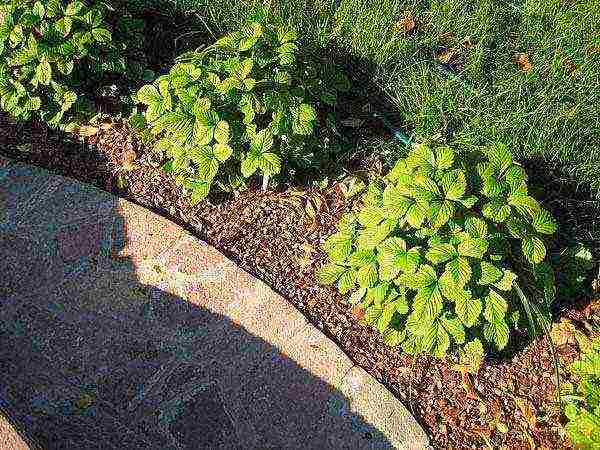
With this planting in spring, the bushes are grown in rectangular ridges at a distance of 50 cm from each other in a short direction and 70 cm in a long direction. With this planting, the seedlings are placed far from each other, the bushes have a lot of space for growth, nutrients and air.
The berries are laid large, ripen quickly and are well stored. The method is laborious, since it requires frequent loosening of the soil, regular weeding, removal of whiskers and mulching. In an arid climate, this method requires frequent watering.
Nests
The nests are placed at a distance of 30 cm from each other, the nest itself consists of 1 central bush and 6-7 peripheral ones, 10 cm distant from the center. It allows you to get a good harvest from a limited area, but requires a lot of sowing material. The size of the berries is small.
Carpet landing option
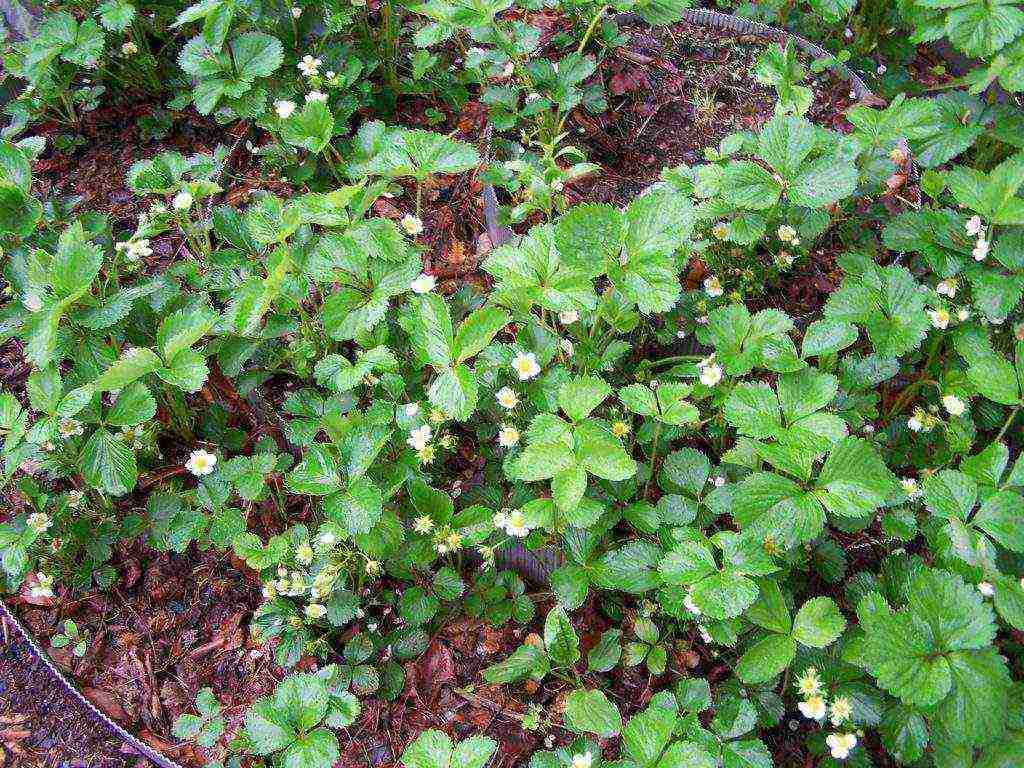
Plants are planted in rows with a step of 7-10 cm, leaving up to 30 cm between rows. The least laborious option for growing strawberries, since it does not require the removal of whiskers and loosening.
The overgrowth of strawberries results in a dense green “carpet” that prevents weeds from sprouting and the soil from drying out quickly. The disadvantages of the method are the small size of the berries and the rapid appearance and spread of rot, so this option is not recommended for shady areas and lowlands.
In strings
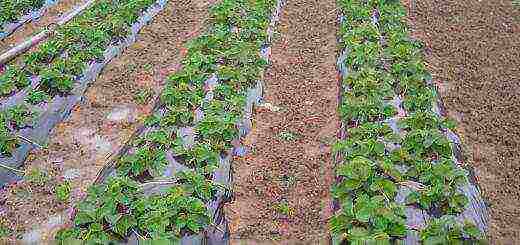
When planting strawberries in rows in spring, the distance between the plants is set at 20-25 cm. With a one-line planting method, the distance between the rows is up to half a meter. The two-line method is preferred when planting on ridges. In this version, the width of the ridge is about 75 cm, and the distance between the rows is 40-60 cm.
The paths between the ridges are laid in 30 cm.
This method is moderately laborious, since it requires the removal of whiskers, periodic loosening of the earth and weeding. The yield is high, the berries are large enough, they are not very susceptible to rot.
On covering material or agrofibre

With any of these options for placing bushes in the spring, except for carpet, it is permissible to use the method of planting seedlings on a dark film or agrofibre. The optimum film thickness is from 150 µm, and agrofibre from 60 g / m².
Agrofibre or film is laid on the prepared and leveled soil, around the perimeter the material is reliably pressed to the ground, for example, with boards, stones or bricks. With long (more than 35 cm high) hairpins made of wire with a diameter of 6 mm, the material is pinned to the ground and markings are applied for seedlings. In the marked areas, the material is cut crosswise, and the edges are folded under agrofibre or film.In these holes, seedlings are planted according to the basic rules.
This method is effective only in the temperate climate of central Russia and in the Urals in well-drained areas. The disadvantage of the method is the high cost of the covering material, but it can significantly reduce the labor costs for further care of berry plantings.
Further care
The first year after spring planting in open ground, strawberries require increased attention. Strawberries are planted early, so berry seedlings need protection from the night cold, for example, with plastic wrap. After the onset of stable heat, the covering material can be removed.
Watering the seedlings is carried out moderately intensively, but often. 14 days after planting, the plants are fed with infusion of vermicompost, bird droppings or herbal infusion.
Peduncles and whiskers on first year plants must be removed. Then more plants will survive the winter, and in the next season overwintered bushes will produce an increased yield.
Do you know?
The seaside of northern France does not boast a resort climate, but every year it attracts thousands of tourists on the second Sunday of June for Strawberry Day at Plugastel, which has become a world famous brand. The day of the holiday is associated with the end of the spring planting of strawberries in open ground.


